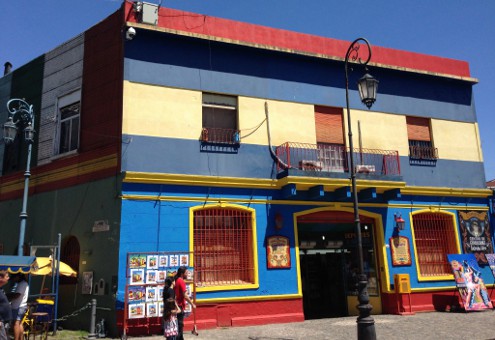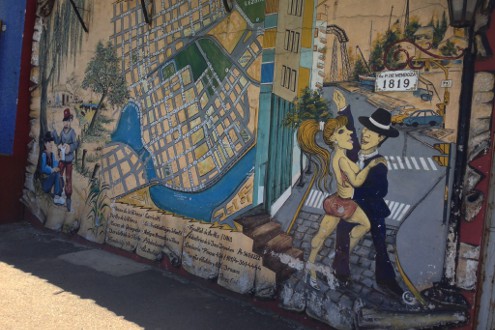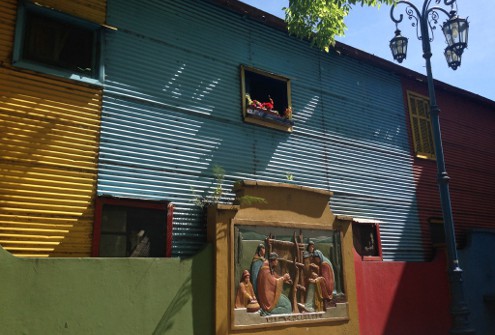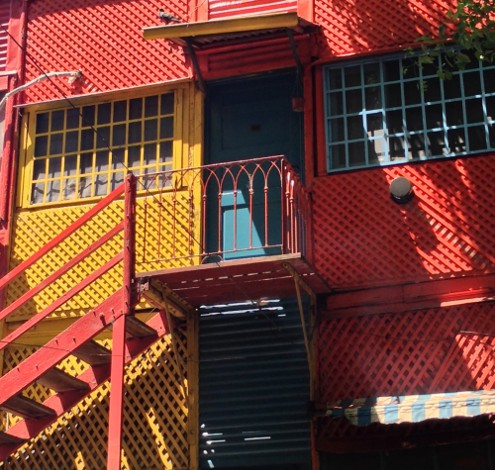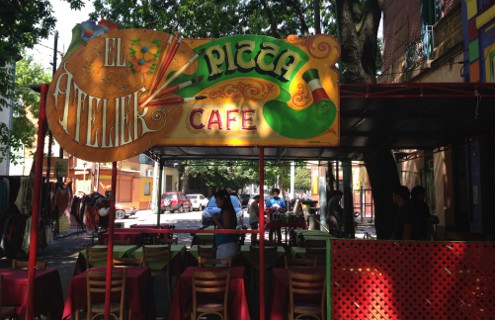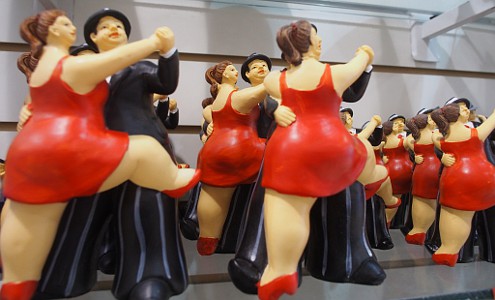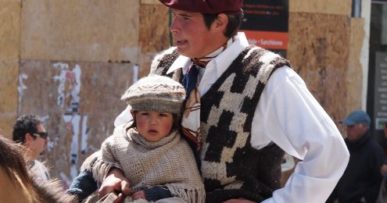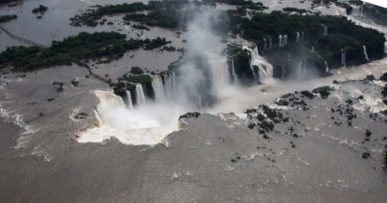The solid blocks of colour on the buildings at La Boca, Buenos Aires, strike you the minute you arrive. Bright blue juxtaposed with bright yellow distinguishes one building, and reflects the home colours of the local soccer team, Boca Juniors. Diego Maradona played for Boca Juniors in 1981 and 1982 and is immortalised in a statue in the museum at the nearby La Bombonera stadium.
Each piece of corrugated iron on the side of another building is painted in a different colour – yellow, mauve, brown, turquoise, red and navy blue. Yet another has blocks of purple, yellow, blue and green.
Home colours of Boca Juniors © Marjie Courtis
The origin of the colourful buildings lies with the fact that early immigrants used left-over boat-building materials for their houses, or at least, whatever leftover paint they could find.
La Boca was the original port of Buenos Aires at the mouth of the river, Rio de la Plata. In fact, La Boca means “the mouth” in Spanish. The paintings of Benito Quinquela Martin, on show in La Boca, focus on the port and its toiling workers. You soon see the blocks of bright colour in the boats, now mirrored by the colours of the housing.
A catastrophe in the form of Yellow Fever came to La Boca in 1871. It left the population depleted, not just from death, but also from the departure of wealthier citizens to Recoleta and other barrios (which means “neighbourhoods”) to avoid the sickness. La Boca started to run down further as its importance as a port declined.
La Boca, run down in places : © Marjie Courtis
La Boca claims to be the Buenos Aires’ barrio that is the birthplace of the Argentinian tango and this neighbourhood shouts “tango” at you, with tango dancers, tango souvenirs and tango music. Tango and colour brought the tourists in and now La Boca is flooded with tourists, shops and restaurants.
There is plenty more to La Boca and much of it relates to the painter Benito Quinquela Martin, who was born, and abandoned, in La Boca in 1890. He remained loyal to the neighbourhood throughout his life, donating the building and paintings that were the beginnings of the current Fine Arts Museum. He said he wanted to give back as much as possible to the neighbourhood that gave him so much.
Quinquela Martin gave his own labour to La Boca too, being responsible for painting the pastel hues that form the backdrop of the walls lining the Caminito (which means “little path”) and became the surface for some bas-relief sculptures lining this tourist-frequented laneway.
La Boca, Colour & Bas Relief Sculpture : © Marjie Courtis
Not surprisingly, Quinquela Martin is now honoured in La Boca as a father as well as a son, with a prominent sculpture of him near the water’s edge.
As well as the Fine Arts Museum, there is a modern art museum showcasing modern Argentinian and international artists, not only in its galleries, but also in its modern restaurant overlooking the docks.
There are some downsides to La Boca in that it’s very touristy, is run down in many places and is known to have attracted criminals and other undesirable types who prey on tourists. I was even persuaded not to take my camera and to limit myself to my iPhone’s camera.
Despite the downsides, if you go to La Boca with the right frame of mind, you can come away loving it almost as much as Quinquela Martin did.
The colours of La Boca : © Marjie Courtis
Restaurants abound in La Boca : © Marjie Courtis
A tango for everyone in La Boca : © Marjie Courtis

